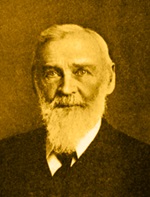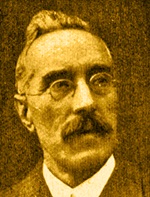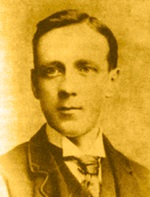In the early morning of August 1, 1895, a brutal incident occurred in Fujian province, China. Hundreds of rioters ambushed a group of foreign Christian missionaries who were vacationing in the mountains, resulting in 11 deaths and five injuries. Among the martyred were several women and children, including a 13-month-old baby.
Coincidentally, on the same day the tragic news reached England, the British and Foreign Bible Society received a letter from a pastor from Fujian, pleading for the publication of a Bible written in a local dialect. The next year, the sister of one of the victims helped publish this Bible, and relatives and friends of the martyrs donated toward the publication costs in remembrance of the massacre.
The Kienning Colloquial Bible is only one of numerous Bible translations that began to appear starting in the 19th century and into the beginning of the 20th, due to the painstaking work of many Western and Chinese translators. The translators were often men, and no one knew how hard they worked better than their wives, who had to force their husbands to eat and sleep because of their never-ending ruminations.
Some of these projects focused on producing a literal word-for-word version of the Bible while others sought a colloquial style. In 1872, a team of 16 Western missionaries and several Chinese Christian experts began work on the Chinese Union Version (CUV) with the intent that it be “in the national language (not local vernacular), simple enough to be understood by people from all walks of life, and faithful to the original text without losing the rhythm of the Chinese language,” as Kevin Xiyi Yao, an expert in world Christianity and Asian studies, wrote for CT.
Below, we highlight 12 of the men who worked on various Chinese translation projects. Each one brought their own translation philosophies and diction preferences, keeping their intended audiences in mind, as they worked to bring the Word of God into Chinese.
The driving force behind the Delegates’ Version: Walter Medhurst

Image: Courtesy of Taiwan Cosmic Light Magazine / Edits by CT
Walter Medhurst
Walter Medhurst (1796–1857) was a missionary from the London Missionary Society. He arrived in Asia in 1816, initially staying in Malaysia and Vietnam before moving to Batavia (modern-day Jakarta) in 1822. In 1843, Medhurst relocated to Shanghai, where he helped develop the city, founding the London Missionary Society Press (LMSP), co-founding Shanghai’s first Western hospital, and serving as the first director of the municipal council.
Medhurst worked as the principal member on the translation committee of at least three versions of the Chinese Bible, including the Four Person Group Version (along with Karl Friedrich August Gützlaff, Elijah Bridgman, and John Robert Morrison), the Nanjing Mandarin Translation, and the New Testament Delegates’ Version, one of the most successful translations of the 19th century, written in the style of ancient Chinese. Medhurst died of illness two days after returning to Britain in 1857, having devoted his life to the Chinese people.
A Chinese Bible translator who helped modernize China: Wang Tao

Image: Courtesy of Taiwan Cosmic Light Magazine / Edits by CT
Wang Tao
Wang Tao (1828–1897) hailed from the eastern Chinese province of Jiangsu. His father, Wang Changgui, worked for LMSP in Shanghai and served as Medhurst’s Chinese teacher. After his father’s death, Wang joined LMSP and helped complete the Delegates’ Version; his exceptional writing style earned him high praise.
Later, Wang accepted an invitation from James Legge to assist in translating the Chinese Confucian texts The Thirteen Classics into English, and worked on the project in England. Wang penned many works of his own and was actively involved in journalism and Western education. He is considered an important figure in China’s path toward modernity.
Protecting the Bible against pirates: Walter Lowrie

Image: Courtesy of Taiwan Cosmic Light Magazine / Edits by CT
Walter Lowrie
Walter Lowrie (1819–1847) was an American Presbyterian missionary and a graduate of Princeton Theological Seminary. His father, Walter Lowrie Sr., served as a US senator before resigning to work as the secretary of the American Presbyterian Mission, and he strongly encouraged his son to join overseas mission work.
Lowrie arrived in China in 1842 and later participated in the work for the Delegates’ Version in Ningbo. But in 1847, he was killed by pirates on his journey back from a meeting in Shanghai. During the struggle, he managed to save the interlinear Hebrew-Greek-English Bible he was holding by throwing it back onto the ship.
A few years later, his younger brother Reuben Post Lowrie (1827–1860) came to China. He also served as a Bible translator and died six years later from illness. Reuben’s son, James Walter Lowrie (1856–1930), served as a member of the translation committee for the Chinese Union Version (CUV), considered to be the predominant Chinese translation of the Bible and the basis for standard translations in use today.
An officer turned translator: Michael S. Culbertson
American Presbyterian missionary Michael S. Culbertson (1819–1862) graduated from the United States Military Academy in West Point, New York, in 1839. In 1841 he retired from the military, entered Princeton Theological Seminary for further studies, and came to China immediately upon graduation in 1844, residing in Ningbo and Shanghai. He joined the translation committee for the Delegates’ Version, but later withdrew because of his differing views. Alongside his friend Elijah Bridgman, he embarked on a new Bible translation project that was supported and published by the American Bible Society in 1855.
Tragically, Culbertson fell ill and died in Shanghai in 1862. His translation, like the Delegates’ Version, was widely circulated and very faithful to the original script, greatly aiding theological students and preachers in their Bible study.
Champion of a colloquial language translation: Calvin Mateer

Image: Courtesy of Taiwan Cosmic Light Magazine / Edits by CT
Calvin Mateer
Calvin Mateer (1836–1908) was another American Presbyterian missionary. He came to China in 1864 and remained for 45 years. His two most significant contributions were the establishment of the Tengchow (Dengzhou) College, which later became Cheeloo (Qilu) University, and his leadership in the initial translation work of the CUV.
In his later years, Mateer stated, “I have devoted my life to the revision work of the Bible. This task cost me a lot of effort, but this is perhaps also the most important work of my life.” He stressed that the primary audience of the CUV were listeners, not readers, as the illiteracy rate in China was still high. And he emphasized the importance of colloquial language, a value which made his translation easy to read out loud.
Mateer also wrote the Course on Mandarin Lessons, which was later reprinted and published by Peking University Press in 2017.
Mateer’s teammate: Wang Yuande
Wang Yuande worked as a translation assistant for Mateer and later wrote about his Bible translation experiences:
Every summer, everyone would bring their draft translations and gather at the Anxie Pavilion on the eastern side of Yantai. They would congregate in one room, each expressing their views and mutually examining evidence. There were times of harmony and friendship, while at others, arguments and disputes ensued. Occasionally, they would slap the table, shout, and storm out in a huff. A moment later, they would return laughing, and begin discussing from the start again. Every time a draft was finalized, it would be after days of eloquent debates which led to indecisiveness. Ultimately, with Western missionaries dominating the discussions, the translators sought agreement with the original text, without putting much effort into the Chinese wordsmithing.
One such translation committee meeting lasted two and a half months. A Tengchow College student later recalled that these debates could be heard by those outside the building.
Wang, along with his predecessor Zou Liwen, were both alumni of Tengchow College. Their and Mateer’s translation work received high commendations from their peers.
The late-stage leader of the Chinese Union Version: Chauncey Goodrich

Image: Courtesy of Taiwan Cosmic Light Magazine / Edits by CT
Chauncey Goodrich
Chauncey Goodrich (1836–1925) was an American Congregationalist missionary who came to China in 1865 to teach at Gordon Memorial Theological Seminary in Tongzhou, Hebei. His interest in Mandarin spurred him to write the Sino-English Pocket Dictionary and Gems of Mandarin.
In 1908 Goodrich became the chair of the translation committee for the CUV. He undertook the substantial responsibility of finishing the Old Testament translation and revising the New Testament.
He once left a translation meeting early due to his daughter’s critical illness, appointing his Chinese translation assistant, Zhang Xixin, to lead in his absence. He frequently praised the efforts and contributions of his Chinese assistants and approved their having the same voting rights as the Western translators. When the CUV was published in 1919, he was the only translator who had participated from start to finish.
He passed away in Tongzhou in 1925 after dedicating 60 years of his life to China. The CUV remains his timeless legacy.
The China Inland Mission translator: Frederick Baller

Image: Courtesy of Taiwan Cosmic Light Magazine / Edits by CT
Frederick Baller
Frederick Baller (1852–1922), a British missionary for China Inland Mission (CIM), came to China in 1873. He launched his missionary work in the provinces of Anhui, Shanxi, Hunan, and Guizhou, conducting surveys and providing relief work.
In 1896 he assumed leadership of the language school situated in Anqing, Anhui, helping newly arrived male missionaries learn Chinese. He was an eminent Chinese scholar and teacher with CIM and authored popular language textbooks, including The Mandarin Primer and An Idiom a Lesson, which were frequently reprinted due to high demand.
He served on the translation committee for the CUV for nearly 20 years as one of the key contributors, alongside Goodrich. He succumbed to illness and died in Shanghai in 1922.
The translator who typed with two fingers: Samuel Isaac Joseph Schereschewsky

Image: Courtesy of Taiwan Cosmic Light Magazine / Edits by CT
Samuel Schereschewsky
Joseph Schereschewsky (1831–1906) was a Jewish Russian who spent his early years studying in a Rabbinic school before converting to Christianity. In 1859, five years after immigrating to America, he was sent by the American Episcopal Church to China, where he translated the Bible into two versions: the Peking Mandarin Version published in 1875 and the Easy Wenli Version published in 1902.
In 1881 he suffered a sun stroke and later became mostly paralyzed from Parkinson’s disease. But this didn’t stop him from completing his translations, typing out the Wenli Version with only one or two functioning fingers. He died in Japan in 1906.
The translator of the Bible for the Miao people: Samuel Pollard

Image: Courtesy of Taiwan Cosmic Light Magazine / Edits by CT
Samuel Pollard
Samuel Pollard (1864–1915) was a British Methodist missionary who left for China in 1887. Beginning his missionary work in Zhaotong, Yunnan, he primarily focused on the Han Chinese. In 1905, in response to the swift growth of evangelism among the minority Flower Miao people, he relocated to a more mountainous area of Guizhou.
Pollard educated locals, built hospitals, advocated for eradicating harmful cultural practices, and defended human rights, actions which collectively sparked a cultural renaissance among the Miao community. He formulated a script for the Miao language, referred to as the Pollard script (or the “Ahmao script”), and consequently translated the New Testament Bible.
In 1915, following an outbreak of typhus fever in the region, Pollard contracted the disease while treating students and subsequently passed away. His New Testament translation into Flower Miao was published two years later. Pollard’s life story was narrated in a series entitled Beyond the Heavens, which was broadcasted on China’s CCTV.
The translator whose daughter was Pearl S. Buck: Absalom Sydenstricker
Absalom Sydenstricker (1852–1931) was a Presbyterian missionary from the southern United States. He came to China in 1880, initially carrying out missionary work in northern Jiangsu. Later, he was invited to lecture at Nanking Theological Seminary. He invested his personal assets and devoted all his efforts to the solitary task of translating the Bible. He passed away from illness in 1931.
His daughter was the distinguished writer Pearl S. Buck (winner of the Pulitzer Prize for Fiction and the Nobel Prize in Literature). In her biography of her father, she criticized his obsessiveness over his work. She noted:
The children always felt that their father’s New Testament was akin to a bottomless pit; it deprived them of their desirable toys or the new dresses that the girls yearned for, as well as the numerous books they craved. They asked hopefully, “Mother, can we purchase some items we want after father finishes the New Testament?” … He repeatedly printed edition after edition, striving for perfection in each one. And [the mother] continually fell into deeper impoverishment throughout her life due to the publication of the New Testament.
A Chinese translator passionate about Greek: Zhu Baohui
Zhu Baohui (1889–1970) studied Greek at Jinling Theological Seminary under the guidance of Francis Perkins, worked as a Greek teacher in the seminary’s correspondence department, and assisted Sydenstricker in translating the New Testament, which was published in 1929.
The year after Sydenstricker died, the responsibility of ongoing revisions fell to Zhu alone. In contrast to Sydenstricker, who favored fluidity of the translation, Zhu placed more emphasis on loyalty to the original Greek. As a result, he included numerous annotations and appendices in his modified translated version, known as The Re-Translated New Testament, which was published in 1936 and was financially supported by Sydenstricker’s daughter Pearl.
In conclusion
Chinese Bible translations were often the result of years of diligence, at times division, and significant group work. While Westerners often numerically dominated the projects mentioned above, Chinese Christians also played a role. (Though, as Wang Yuande notes, the foreigners outtalked nearly everyone else.)
Ultimately, the most significant project to come out of these projects was the CUV. Yao writes:
The timely arrival of the CUV provided the Chinese Protestant community with a ready-made set of theological notions and vocabulary that Chinese believers immediately received and embraced. It did not take long for the CUV’s translation of such key biblical terms as faith, sin, salvation, and grace to become the standard “language of faith” used by church leaders, theologians, and evangelists as well as the average churchgoer on a daily basis.
The CUV’s translation of key biblical terms has been deeply ingrained in the theological DNA of the Chinese Protestant community around the world. It is fair to say that this is the only theological language system known and used unquestionably by this community up to today.
Wei Wai-Yang, a retired lecturer from Central University of Taiwan and vice secretary general of Cosmos Light Holiness Church School, has been committed to researching the history of Chinese Christianity for many years. He has several related publications, one of which is Clouds That Stay in the Distance.
This piece was adapted from Chinese. Read the original in traditional Chinese and simplified Chinese.




























![[Video] More – Aghogho » GospelHotspot](https://gospelhotspot.net/wp-content/uploads/2024/04/More-Aghogho.jpeg)
















